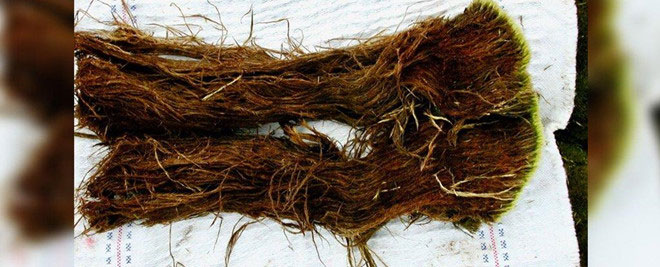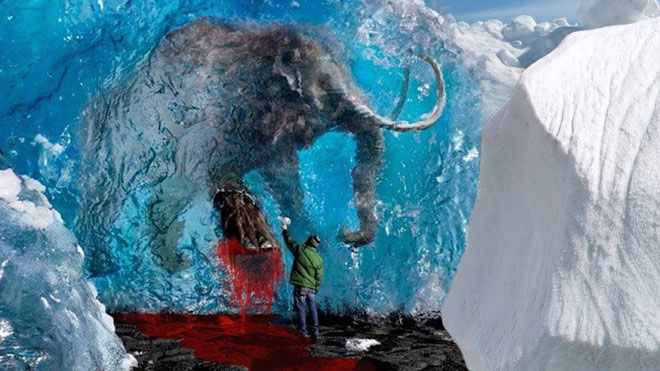The 41,000-year-old worm is resurrecting from ice
The multicellular bacteria and animals are gradually recovering when the polar ice begins to melt. One of the specimens has a life expectancy of up to 41,000 years.
Around 1550-1850, a cold spell called "Little Ice" affected the Arctic. After that, cold air continued to spread to Ellesmere Island (Canada) and freeze a small moss of Aulacomnium turgidum .
From small moss beams
After centuries of under the thick ice, moss beams have been found by biologists Catherine La Farge. Surprisingly, it is still green - a sign of life.

The moss is "awakened" after centuries of sleeping.(Photo: Science Alert).
Melting ice is revealing the story of many special creatures, expressing incredible resilience. These ice ages include many types, from bacteria to multicellular animals. They have such a strong tolerance that scientists have to reconsider the concept of life.
'The revival after hundreds of years of basic burial is very unbelievable , ' said biologist Catherine La Farge, who is currently studying algae at the University of Alberta.
In 2009, La Farge's group scoured the remains of the glacier after melting. The goal of the group is to reproduce the vegetation that once existed on Ellesmere Island.
'These specimens are often thought to be dead. But when I saw the green tissue, I immediately thought that this was unusual, ' La Farge said of the experience of discovering ancient moss .
She brought them back to Edmonton (Canada) to continue caring in a nutritious environment. As a result, nearly one-third of the sprouting specimens and new leaves.

The revival from ice seems to be only in fantasy movies.(Photo: Racer).
In fact, surviving after being frozen is not easy. Ice crystals will break down cell membranes and many other organs. Many creatures cannot even stand the winter cold.
However, moss has a special mechanism to survive. They absorb moisture when the temperature decreases, causing the ice to not form in tissues. Even if a part is damaged, cells can divide and differentiate to create replacement tissue, similar to human embryonic stem cells.
Before successfully resurrecting the moss in Canada, La Farge's team worked with a 1,500-year-old sample of moss buried in the Arctic permafrost.
"The permafrost is very stable," said biologist Peter Convet of the British Arctic Research Institute, noting that ice can isolate organisms from surface damage.
The 41,000-year-old worm is emerging
At the University of Tennessee, microbiologist Tatiana Vishnivetskaya successfully awakened millions of years of bacteria.'They are very much like the bacteria that are found in cold environments today , ' she said.
Last year, her group even went further when successfully reviving round worms with complete head and anus. This is the most complex creature that ever lived up after long freezing.
' Of course, we are very surprised and excited , ' Vishnivetskaya said. She estimated the worm was 41 thousand years old and had lived in the Neanderthal period.

Descendants of the nematode species still exist today.(Photo: MNN).
Experts believe that nematodes are resistant to freezing for millennia. This animal has a diverse habitat, even exists in the South African mine with low oxygen and high temperatures.
When environmental conditions worsen, some nematode species may fall into a 'dauer ' state - the time when they stop eating and form a protective layer from outside harsh elements.
Geatan Borgonie - a nematode researcher in Gentbrugge (Belgium) - assesses the revival process that Vishnivetskaya's team made is 'a big surprise'.
'It seems to be good news for the Solar System,' he said. Borgonie suggested that this biological achievement may suggest life on other planets.

This biological achievement may reinforce the idea of life on extraterrestrial planets.(Photo: Ever Circles).
Particularly on Earth, many species are gradually extinct when humans disturb the global climate. But near the melting area, a few species showed incredible stamina.
The migration process to find a favorable environment is no longer strange to animals. But now, in addition to traveling through space, they also have new options: Going through time .
After prolonged sleep in the coldest region of the Earth, bacteria, moss and nematodes are waking up in a new geological era. With this revival, the weather seemed warmer.
- Finding out the mechanism of death of the roundworm, we will take a step closer to immortality
- Biological clock: Find the time-controlling gene in C.elegans
- 'Happy New Year' is spreading strongly
- Discover the world's most peculiar worm
- Discovered a new worm frog in Vietnam
- Deep birds and basic information about this bird
- The animal with 50 living parts 550 million years ago could decipher the secret of life
- The worm re-grows its head after breaking with the intact brain
- Little is known about Vietnam's tiny worm worm
- New IM worm ... chat with the victim himself
- New worm alerts attack Yahoo Mail!
- The new worm attacks Yahoo Messenger users
- The 91-year-old grandmother died, suddenly resurrecting in the frozen morgue
- Earth used to have a 10-meter-long worm
 Animal 'suffering' after hibernation
Animal 'suffering' after hibernation Why do goats climb well?
Why do goats climb well? Scientists were surprised to see chimpanzees eating turtles
Scientists were surprised to see chimpanzees eating turtles Giant catfish died deadly due to drought in Thailand
Giant catfish died deadly due to drought in Thailand Bio-receptive concrete promotes moss growth
Bio-receptive concrete promotes moss growth  The mysterious 'Glacier Mouse' has no solution
The mysterious 'Glacier Mouse' has no solution  The reproductive organ of moss is the inspiration designed for pipettes
The reproductive organ of moss is the inspiration designed for pipettes  Ancient moss species has been prepared for humanity to appear
Ancient moss species has been prepared for humanity to appear  Ancient moss revival after 1,500 years of sleep
Ancient moss revival after 1,500 years of sleep  Revitalizing frozen moss 400 years
Revitalizing frozen moss 400 years 